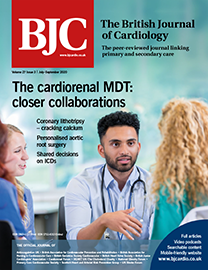Editorials
Clinical articles
News and views
Topics include:-
- The cardiorenal MDT: closer collaborations
- Coronary lithotripsy – cracking calcium
- Personalised aortic root surgery
- Shared decisions on ICDs
September 2020 Br J Cardiol 2020;27:77–8 doi:10.5837/bjc.2020.025
Luke Pickup, Jonathan P Law, Jonathan N Townend, Charles J Ferro
Abstract

“Alone we can do so little, together we can do so much.” Helen Keller
The links between kidney disease and cardiovascular disease have been reported as far back as 1827 with Richard Bright describing the changes in the left ventricle associated with kidney disease, and subsequently, Frederick Akbar Mahomed reporting increased arterial stiffness in patients with Bright’s disease.1 Over the last two to three decades it has become increasingly apparent that kidney disease is the most important predictor of outcomes in all cardiology diseases and that cardiovascular disease is the leading cause of death in patients with chronic kidney disease.2 In 2008, a systematic approach to the bi-directional interactions of heart and kidney diseases, or cardiorenal syndromes (table 1), was proposed.3 Cardiorenal syndromes can be broadly defined as disorders of the heart and kidney whereby acute or chronic dysfunction in one organ can induce acute or chronic dysfunction in the other.4 This was followed by increasing efforts to develop strategies to manage patients with combined heart and kidney dysfunction, as demonstrated by an increasing number of publications on cardiorenal syndromes.5
|
Full text
July 2020 Br J Cardiol 2020;27:79
Terry McCormack
Abstract

In 2015 one of my patients in the Fourier PCSK9 inhibitor trial asked me if I would like to attend his ‘bespoke’ total knee replacement operation. I said yes and witnessed an amazing procedure.
|
Full text
Clinical articles
Back to top
September 2020 Br J Cardiol 2020;27:80–2 doi:10.5837/bjc.2020.026
Rajiv Sankaranarayanan, Homeyra Douglas, Christopher Wong
Abstract

Cardiorenal syndrome is a complex condition associated with significant morbidity in the form of symptoms secondary to fluid overload, leading to hospitalisations, and portends increased mortality. Both the diagnosis and management of the conditions are complicated by the fact that there is dysfunction of the heart as well as the kidney, usually with uncertainty with regards to the timing of the first insult. Management in primary care, or in the emergency setting, tends to be predominantly focused on short-term improvement in function of one organ, leading to deleterious effects on the other. A consensus multi-disciplinary approach involving both cardiologists and nephrologists has been advocated in order to devise a unified management plan. Our report presents findings of monthly cardio-nephrology multi-disciplinary team meetings and illustrates that this can be an efficacious approach both in terms of avoiding unnecessary outpatient clinic visits, as well as consensus decision-making.
|
Full text
September 2020 Br J Cardiol 2020;27:100–1 doi:10.5837/bjc.2020.027
Mohsin Gondal, Ali Hussain
Abstract

Ventriculophasic arrhythmia (VPA) is an intriguing electrocardiogram (ECG) phenomenon, often seen in patients with complete heart block, and could sometimes pose a challenging diagnostic dilemma for physicians. By definition, in VPA, the P–P intervals that contain a QRS complex are shorter than the P–P intervals that do not have a QRS complex. VPA is often a tell-tale ECG finding of complete heart block. We describe a case in which paroxysmal VPA led us to diagnose complete heart block.
|
Full text
September 2020 Br J Cardiol 2020;27:102–4 doi:10.5837/bjc.2020.028
Marina Pourafkari, Prodipto Pal, Adriana Luk, Daniel Ennis, Mini Pakkal, Patrik Rogalla
Abstract

Immunoglobulin G4-related disease (IgG4-RD) is a systemic fibro-inflammatory immune-mediated disease, which has been defined in the past few years. IgG4-RD affects various organs and leads to a variety of clinical manifestations. As it is a relatively newly defined entity, new manifestations are now being recognised and reported. We describe a case involving the cardiovascular system.
|
Full text
July 2020 Br J Cardiol 2020;27:83–6 doi:10.5837/bjc.2020.021
Paula Finnegan, John Jefferies, Ronan Margey, Barry Hennigan
Abstract

 This article is available as a BJC Learning CPD activity
This article is available as a BJC Learning CPD activity
Coronary lithotripsy is a novel approach to percutaneous coronary intervention (PCI). It is based on well-established technology dating back to 1980 when lithotripsy was first used to treat renal calculi. Its application in cardiovascular medicine is a more recent development that involves using a low-pressure lithotripsy balloon to deliver unfocused acoustic pulse waves in a circumferential mechanical energy distribution. This causes fracturing of calcification within the surrounding vasculature, facilitating optimal stent deployment.
This article aims to review recent clinical experience and the published data regarding intravascular lithotripsy (IVL). All relevant articles were identified via PubMed using keywords including “intravascular lithotripsy”, “shockwave” and “coronary”. All studies that contained published datasets regarding IVL with patient numbers >50 were included for review. There were 116 results found. After reviewing all the publications, articles were then tabulated and 17 were found to be relevant, including only four clinical studies.
In this review we found that intracoronary lithotripsy for heavily calcified arteries appears to be a safe, effective, easy-to-use method of dealing with an otherwise technically-challenging and high-risk scenario. It appears to carry low risk, uses low pressures, and exerts its effects on both superficial and deep intravascular calcium. Further prospective data with long-term follow-up will be required to explore both the off-label uses of IVL (such as post-stent dilatation), and the long-term patency of these vessels.
|
Full text
July 2020 Br J Cardiol 2020;27:87–92 doi:10.5837/bjc.2020.022
John Pepper, Tal J Golesworthy, Cemil Izgi, Johanna J M Takkenberg, Tom Treasure
Abstract

Patients with congenitally determined aortic root aneurysms are at risk of aortic valve regurgitation, aortic dissection, rupture and death. Personalised external aortic root support (PEARS) may provide an alternative to aortic root replacement.
This was a multi-centre, prospective cohort of all consecutive patients who received ExoVasc mesh implants for a dilated aortic root between 2004 and 2017. Baseline and peri-operative characteristics, as well as early postoperative outcomes are described, and time-related survival and re-operation free survival are estimated using the Kaplan-Meier method.
From 2004 through 2017, 117 consecutive patients have received ExoVasc mesh implants for aortic root aneurysm. The inclusion criteria were an aortic root/sinus of Valsalva and ascending aorta with asymptomatic dilatation of between 40 and 50 mm in diameter in patients aged 16 years or more. Patients with more than mild aortic regurgitation were excluded. There was one early death. The length of stay was within seven days in 75% of patients.
In conclusion, the operation achieves the objectives of valve-sparing root replacement. PEARS may be seen as a low-risk conservative operation, which can be applied earlier on in the disease process, and which is complementary to more invasive procedures, such as valve-sparing root replacement or total root replacement.
|
Full text
July 2020 Br J Cardiol 2020;27:93–6 doi:10.5837/bjc.2020.023
Honey Thomas, Mark Lambert, Chris Plummer, Craig Runnett, Richard Thomson, Anne Marie Troy-Smith, Andrew J Turley
Abstract

The National Institute for Health and Care Excellence (NICE) and NHS England have shown a commitment to embedding shared decision-making (SDM) in clinical practice and developing decision aids based on clinical guidelines. Healthcare policy makers are keen to enhance the engagement of patients in SDM in the belief that it improves the benefits accrued from healthcare interventions. This may be important for interventions such as implantable cardioverter-defibrillator (ICD) implantation, where cost-effectiveness is under scrutiny. NHS England invited the ICD implanters in the north of England to participate in a regional commissioning quality incentive (CQUIN) project to improve decision-making around a primary prevention ICD implant. A collaborative project included the development of a specific SDM tool, the first of its kind in the UK, followed by training and education of the clinical teams. The project illustrates that this approach is practical and deliverable and could be applied and used in other regions, and considered in additional clinical areas.
|
Full text
July 2020 Br J Cardiol 2020;27:97–9 doi:10.5837/bjc.2020.024
Holly Morgan, Christopher Williams, Robert A Bleasdale
Abstract

Computed tomography (CT) is a widely available imaging modality and artefactual findings are not uncommon, particularly in the presence of foreign bodies.
We conducted a retrospective analysis of all CT scans carried out in our trust in a 12-month period, identifying all reports containing the word “pacemaker”. There were 88 scans identified, six of which reported findings related to the pacemaker. In five cases right ventricular lead perforation was reported. All patients underwent further investigations, which did not show any evidence of true lead perforation.
In conclusion, it is important that both cardiologists and radiologists are aware of the possibility of artefactual lead perforation on CT.
|
Full text
News and views
Back to top
September 2020 Br J Cardiol 2020;27:79 doi:10.5837/bjc.2020.029
The British Association for Cardiovascular Prevention and Rehabilitation (BACPR), the British Dietetic Association (BDA) and the Public Health Nutrition Specialist Group (PHNSG) have issued...
August 2020
We were shocked to hear the sad news of a dear friend passing away, Dr Michael Schachter (Senior Lecturer in Clinical Pharmacology, National Heart...


